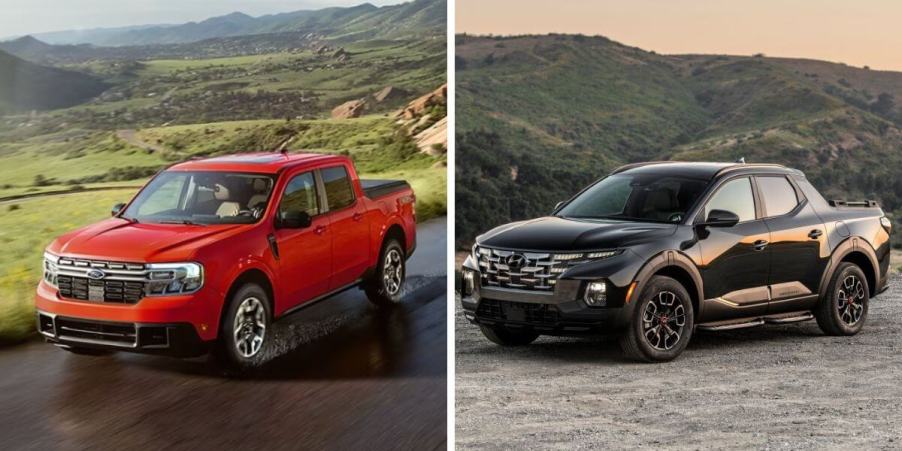
2024 Ford Maverick vs. 2024 Hyundai Santa Cruz: Small Truck Struggle
The recently defunct compact truck segment was revived for the 2022 model year when both the Ford Maverick and Hyundai Santa Cruz hit the market. These small pickups have proved popular, and more rivals could soon enter the fray. Still, the Maverick and Santa Cruz are currently the only options for small pickups, so how do their latest updates compare?
Both models are available with a choice of powertrains
The most notable change in how the 2024 Hyundai Santa Cruz and Ford Maverick stack up can be found under the hood.
For the 2024 model year, the Maverick has switched up its engine options. The previously optional 2.0-liter EcoBoost engine delivering 250 horsepower and 277 lb-ft of torque is now the standard engine. Meanwhile, the formerly standard 2.5-liter hybrid unit producing 191 hp is now available for any of the three Maverick trims as a $1,500 option.
The gas-only Maverick pairs with an eight-speed automatic and is available with all-wheel drive (FWD is standard), while the hybrid is fitted with continuously variable transmission and is only offered with front-wheel drive.
The Santa Cruz also offers a choice of engine options, but both are powered exclusively by gasoline. The standard engine is a 2.5-liter four-cylinder developing 191 hp and 181 lb-ft of torque, while a turbocharged 2.5-liter is available to crank out 281 hp and 311 lb-ft of twist.
Both Hyundai engines are paired to an eight-speed automatic transmission — though the turbo engine gets a dual-clutch — with standard front-wheel drive and AWD available.
Little trucks with respectable capabilities
Unlike their full-size counterparts, the Hyundai Santa Cruz and Ford Maverick are only available in extended cab configurations with one bed size. The two pickups are sized similarly on the inside, each with slight advantages in passenger accommodations. For instance, the Maverick offers 42.8 inches of front legroom to the Hyundai’s 41.4, but the Santa Cruz delivers slightly better rear head, leg, and shoulder room.
The Ford earns a more decisive victory in bed size. The Maverick’s bed length is 54.4 inches, while the Santa Cruz settles for 48 inches. The width of both beds is 53 inches.
The Santa Cruz has the overall advantage in towing with its ability to haul 3,500 pounds with the standard engine and up to 5,000 pounds, notably more than the Maverick’s 2,000 standard capacity and 4,000 maximum load. However, there is a caveat as the Hyundai can only haul those figures with an aftermarket trailer brake controller — a controller that isn’t installed from the factory.
Both models are equipped with four-pin connectors as standard. Seven-pin connectors require the EcoBoost engine and the 4K Tow Package ($745) for the Ford, while Santa Cruz buyers must dish out at least $38,210 for a model with the turbocharged engine for seven-pin connectors.
Still, for those needing limited truck capabilities, the Santa Cruz has an SUV-like ride — no surprise as it’s based on the Tucson — far more compliant and supple than the Maverick.
The Ford Maverick is notably more economical
The Ford Maverick’s optional hybrid powertrain makes it the obvious choice for compact truck buyers seeking to save money on fuel bills. It delivers an impressive 37 combined mpg, according to the EPA. The Ford is also the more economical choice with the EcoBoost engine, rated for up to 26 combined mpg, while the Hyundai Santa Cruz maxes out at 23 combined mpg with the standard engine. As for its upgraded powertrain, the Hyundai returns 22 combined mpg when equipped with its turbocharged unit.
The Hyundai Santa Cruz costs more but offers more features, better warranties
The Maverick will save buyers dough at the dealer as well. The 2024 Ford Maverick starts at $23,400, while the base 2024 Hyundai Santa Cruz carries a $26,650 MSRP. The Santa Cruz is available in five trims to the Maverick’s three, and the upper models can crest the $40,000 mark while the Maverick maxes out at $34,855 MSRP for a range-topping Lariat model.
However, the Hyundai offers a lot of bang for the buck. Its upper trims are rich with features and creature comforts the Ford can’t match no matter the model or how many options boxes are ticked. The base Santa Cruz also offers more for the money. It’s equipped as standard with a suite of driver’s aids like automatic forward emergency braking, lane-keep assist, blind-spot monitoring with steering assist, and rear cross-traffic warning, while the Maverick is limited to automatic forward emergency braking. Both base models are fitted with eight-inch touchscreens, cloth upholstery, six-speaker audio systems, and Apple CarPlay and Android Auto connectivity as standard. However, the Santa Cruz’s cabin is more upscale and features slightly fewer spartan appointments.
Lastly, the Hyundai small truck also has a massive advantage in warranties, which could certainly make up for its added initial cost. The 2024 Santa Cruz comes with a five-year/60,000-mile basic warranty, a 10-year/100,000-mile powertrain warranty, seven-year rust coverage, free maintenance for three years/36,000 miles, and free roadside assistance for five years. In comparison, the Maverick’s three-year/36,000-mile basic warranty, five-year/60,000-mile powertrain warranty, and five years of rust protection seem pretty paltry.




